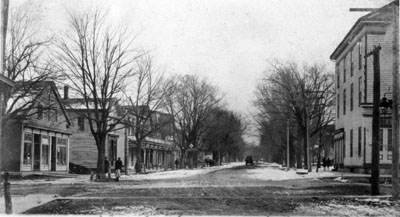Charlene Cole
Sandy Creek/Lacona Historian
Historian's Corner
July ?, 2015
Photo: Today the corner of Harwood Drive and North Main Street. The building on the left was the home of William Cottrell from the 1830’s when it featured a shady porch across the front and a picket fence along the edge of the street. It became a store in 1895 and wide windows were added to the front. In 1907, local carpenter, Andrew J. Sprague built the two-story addition on the front, reusing the store windows as well as Greek Revival and Italiante details to produce a “composite style” building. (Kessler’s, Karen’s Kountry Flowers were located at this site and today the Antique Shop.
This photo dating before 1912 shows the California Block on the right, today the village park before the fire.)
|
 |
Roads in Pioneer Times
The first road through the Town of Sandy Creek is said to have been cut out in the summer of 1802, passing from Redfield through Orwell to what is now Ellisburg. In September of that year Rev. John Taylor made a missionary tour into this county and passing over this road said “Rode two miles from Redfield Square and entered into a wilderness of 24 miles without a house. The road was cut out this summer and is a tedious, hilly, rooty, muddy, stumpy, solitary road.” It is believed that this was the Orwell Road and the Ridge Road North, for some distance at least. The first settlers came to this town in 1803.
Most of the pioneers who settled in this section came in over the route from Rome through what is now Florence, in Oneida County; it was merely a wagon way cut through the forest and was often almost impassable. What became known as the State Road went from Rome and ran through Redfield and the northern part of Boylston to Sackets Harbor; it was used for the passage of troops in the War of 1812. Prior to 1812 the “Great Road” was opened through to Sackets Harbor and during the war was of great and unexpected benefit for the passage of troops to that important military point. The goings and comings of the soldiers furnished the inhabitants considerable excitement. Immigration and other travel made the State Road a busy highway.
The road from Port Ontario pass the Center Church and into Ellisburg (Scenic Highway) was an important thoroughfare in former days and there were hotels every mile or so, including the Fitch and the Lindsey Hotel. It was called the State Road.
Mail facilities through the county were few. Between 1810 and 1817 the only post route was from Oswego to Onondaga by way of Three Rivers, Liverpool and Salina. In 1817 a route was established from Oswego Falls to Rochester and this was supplemented in 1825 by another extending from Watertown by way of Sandy Creek to Richland, Union Square, Colosse, Central Square and Syracuse.
The Rome and Watertown Railroad Company chartered in 1832 when the railroad fever was at its height, began operations at Rome in November 1848 and May 1851, the road was completed to Pierrepont Manor, passing through the towns of Amboy, Williamstown, Albion, Richland and Sandy Creek.
Previous to the completion of the railroad in 1851, freight was brought by teams, usually from Sackets Harbor or Rome. To Rome the nearest way was through the town of Redfield. As late as 1830 and possibly later, there were nine miles of thick, dense forest to pass through, unbroken save by roads, so narrow that teams were unable to pass each other except at points where it had been widened for that purpose. They were known as the “Redfield Nine Mile Woods” and were infested by bears. The locality was noted for its deep snows, and so little sunlight pierced the gloom of this forest that snow was often found as late as May and even June. |
Charlene Cole
Sandy Creek/Lacona Historian
1992 Harwood Drive
Sandy Creek, NY 13145
315-387-5456 x7
office hours: Friday 9am to 2pm
www.sandycreeknyhistory.com |

